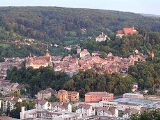
Sighisoara Citadel
Encyclopedia
The Sighișoara Citadel is the old historic center of the town of Sighișoara
, Romania
, built in the 12th century by Saxon
colonists under the Latin name Castrum Sex. It is an inhabited medieval citadel that, in 1999, was designated a UNESCO
World Heritage Site
for its 850-year-old testament to the history and culture of the Transylvanian Saxons
.
Birthplace of Vlad III the Impaler
(in Romanian Vlad Țepeș), Sighișoara hosts, every year, a medieval
festival where arts and crafts blend with rock music and stage plays. The city marks the upper boundary of the Land of Sachsen
. Like its bigger brothers, Sibiu
(Hermannstadt - The European Cultural Capital in 2007) and Braşov
(Kronstadt), Sighișoara exhibits architecture
typical of medieval Germany. During the Communist
era, this German
area was preserved, and the original architecture is still in place.
Sighisoara
Sighişoara is a city and municipality on the Târnava Mare River in Mureş County, Romania. Located in the historic region Transylvania, Sighişoara has a population of 27,706 ....
, Romania
Romania
Romania is a country located at the crossroads of Central and Southeastern Europe, on the Lower Danube, within and outside the Carpathian arch, bordering on the Black Sea...
, built in the 12th century by Saxon
Saxons
The Saxons were a confederation of Germanic tribes originating on the North German plain. The Saxons earliest known area of settlement is Northern Albingia, an area approximately that of modern Holstein...
colonists under the Latin name Castrum Sex. It is an inhabited medieval citadel that, in 1999, was designated a UNESCO
UNESCO
The United Nations Educational, Scientific and Cultural Organization is a specialized agency of the United Nations...
World Heritage Site
World Heritage Site
A UNESCO World Heritage Site is a place that is listed by the UNESCO as of special cultural or physical significance...
for its 850-year-old testament to the history and culture of the Transylvanian Saxons
Transylvanian Saxons
The Transylvanian Saxons are a people of German ethnicity who settled in Transylvania from the 12th century onwards.The colonization of Transylvania by Germans was begun by King Géza II of Hungary . For decades, the main task of the German settlers was to defend the southeastern border of the...
.
Birthplace of Vlad III the Impaler
Vlad III the Impaler
Vlad III, Prince of Wallachia , also known by his patronymic Dracula , and posthumously dubbed Vlad the Impaler , was a three-time Voivode of Wallachia, ruling mainly from 1456 to 1462, the period of the incipient Ottoman conquest of the Balkans...
(in Romanian Vlad Țepeș), Sighișoara hosts, every year, a medieval
Middle Ages
The Middle Ages is a periodization of European history from the 5th century to the 15th century. The Middle Ages follows the fall of the Western Roman Empire in 476 and precedes the Early Modern Era. It is the middle period of a three-period division of Western history: Classic, Medieval and Modern...
festival where arts and crafts blend with rock music and stage plays. The city marks the upper boundary of the Land of Sachsen
Transylvanian Saxons
The Transylvanian Saxons are a people of German ethnicity who settled in Transylvania from the 12th century onwards.The colonization of Transylvania by Germans was begun by King Géza II of Hungary . For decades, the main task of the German settlers was to defend the southeastern border of the...
. Like its bigger brothers, Sibiu
Sibiu
Sibiu is a city in Transylvania, Romania with a population of 154,548. Located some 282 km north-west of Bucharest, the city straddles the Cibin River, a tributary of the river Olt...
(Hermannstadt - The European Cultural Capital in 2007) and Braşov
Brasov
Brașov is a city in Romania and the capital of Brașov County.According to the last Romanian census, from 2002, there were 284,596 people living within the city of Brașov, making it the 8th most populated city in Romania....
(Kronstadt), Sighișoara exhibits architecture
Architecture
Architecture is both the process and product of planning, designing and construction. Architectural works, in the material form of buildings, are often perceived as cultural and political symbols and as works of art...
typical of medieval Germany. During the Communist
Communism
Communism is a social, political and economic ideology that aims at the establishment of a classless, moneyless, revolutionary and stateless socialist society structured upon common ownership of the means of production...
era, this German
Germans
The Germans are a Germanic ethnic group native to Central Europe. The English term Germans has referred to the German-speaking population of the Holy Roman Empire since the Late Middle Ages....
area was preserved, and the original architecture is still in place.

